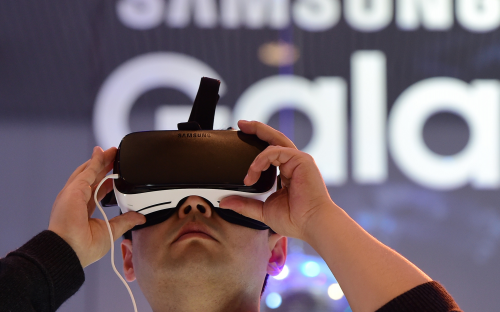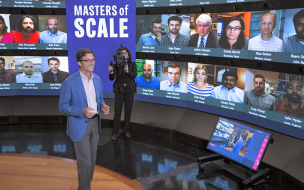Google, Apple and Samsung are betting that these sci-fi concepts will become a staple of everyday life, with potential uses in gaming, advertising, marketing and increasingly, education.
The hype surrounding VR and the more complex augmented reality, is not lost on universities and business schools, who are eyeing its early pioneers and conducting secretive trials of head-mounted VR displays.
Four of the world’s top-ranked schools have told BusinessBecause they are exploring VR in tie-ups with Oculus, Samsung, and Google, as they place bets on the next big innovation in online learning.
“We’ve started thinking about true virtual reality — headsets. But we are months or years away,” says Peter Hirst, associate dean of executive education at MIT Sloan School of Management, which has trialled Google’s Cardboard and Samsung’s Gear.
However, he expects quicker adoption as the technology improves and costs come down. “The next generation of VR — that’s going to replace the traditional notion of sitting in front of a computer,” Peter says.
Robin Teigland, an innovation-pioneering professor at the Stockholm School of Economics, says she has taught two groups of executives using Gear in a VR initiative sponsored by Samsung.
Robin does not envisage widespread adoption — yet. But she believes VR is coming to business schools: “If you think about the money being pumped into it by Facebook, Google or Alibaba, developments are coming,” she says.
Interest is spurred by the growth of the frothy VR market, estimated to hit $70 billion in 2020, according to Taiwan-based TrendForce, a market research group.
Magic Leap, a Florida VR start-up, raised this month $800 million from Google and Alibaba, the Chinese e-commerce group, giving it a valuation of $4.5 billion. Bigger rivals, including Microsoft and Apple, are pouring investment into augmented reality technologies in the belief they could eventually supplant smartphones and PCs. “The opportunities are endless,” says Christopher Mitchell, head of Razer OSVR, the gaming company’s virtual reality headset.
Razer OSVR is working with universities to improve learning and iron out VR’s kinks. “As hardware gets more accessible and affordable, you’ll see more interactive learning experiences that were never possible before,” Christopher says.
Business schools’ interest points to a lucrative potential market tech groups leading VR development. Annual sales for head-mounted display units are poised to hit 24 million by 2020, according to Futuresource Consulting.
A spokesperson at Oculus VR, which was acquired by Facebook for $2 billion in 2014, says virtual reality will be one of education’s next big innovations. “The ability to train and communicate using VR will enable educators to provide a level of immersion never before experienced,” they said.
Microsoft says it’s HoloLens “mixed reality” device will be a revolutionary tool for businesses — it could transform how companies work with data to bring products and information to life. “This is just the beginning,” a spokesperson says.
Not many business schools say VR will spur widespread headset adoption at current price points. But most recognize the need to innovate.
“We’re keeping a close eye on it,” says Michael Koenig, senior assistant dean for degree programs at Virginia’s Darden School of Business, but the investment required is high, he says.
James Henderson, professor responsible for innovation at IMD, says the Swiss business school has explored virtual reality and “virtual faculty” through holographs. “[But] at the moment they have not at all gone mainstream,” he says, pointing to lack of faculty demand.
Other hurdles include access: just 1% of current PCs can handle virtual applications using headsets such as Oculus Rift and HTC Vive, according to Nvidia. “With virtual reality you have to get the technology in the hands of the student — that’s a hurdle,” says Patrick Mullane, executive director of HBX, Harvard Business School’s online learning initiative.
But, as VR technologies improve, they will be able to make the on-campus experience more robust. “It’s one experience to read a case study, and another to virtually live it,” says Anne Trumbore, director of Wharton Online.
The trend for business schools to explore VR began in the executive education space. MIT Sloan and Stanford’s Graduate School of Business for example pioneered virtual interactions for executives who have uploaded avatars to an online world.
“Jumping into this space, no one knew what to expect,” says Fernando Contreras, associate director for extended learning at Stanford GSB, whose LEAD program created a virtual campus for executive students.
Today, virtual spaces are becoming more popular as pioneers such as Magic Leap make headlines. “[It] is giving people optimism of how it can be used in education through things like Oculus Rift,” Fernando says.
Now, business schools are experimenting with more advanced forms of virtual and mixed reality.
Roger Delves, dean of qualifications at Ashridge Business School, says getting students’ online experiences as close to reality as possible will be a significant challenge for schools over the next decade. “We’re constantly trying to get closer to augmented reality,” he says.
RECAPTHA :
8b
01
73
93










